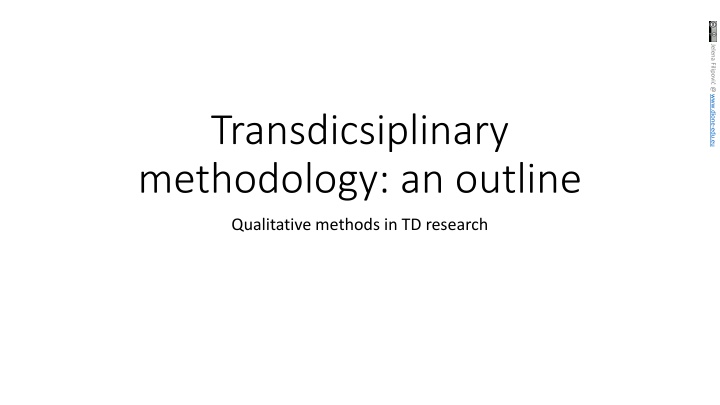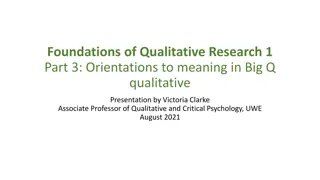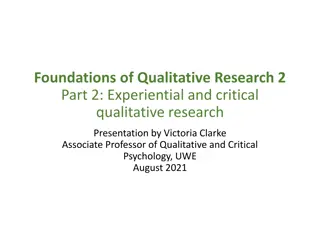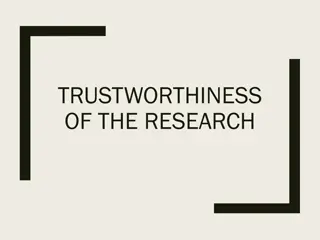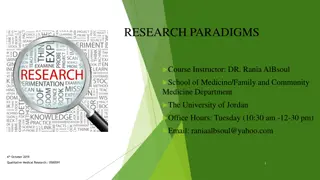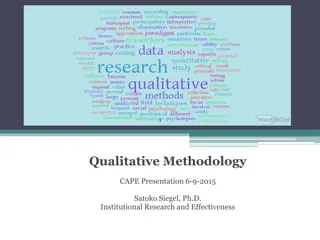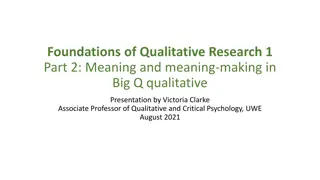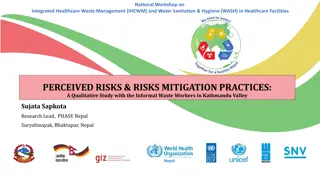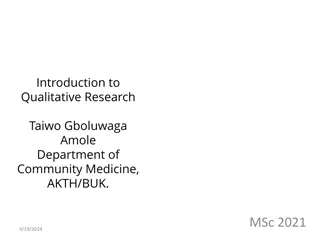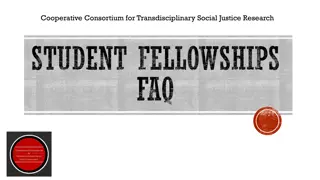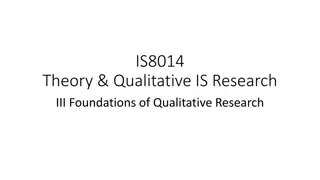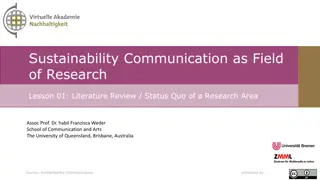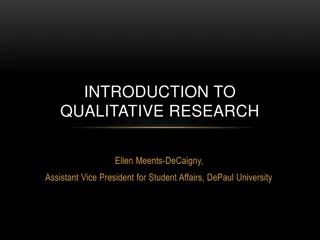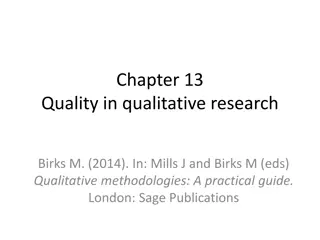Qualitative Research Methodologies in Transdisciplinary Studies
A comprehensive overview of qualitative methodologies in transdisciplinary research, emphasizing their critical, interpretative, and contextualized approaches to data construction, analysis, and knowledge formation. Explore how qualitative methods complement quantitative approaches, providing insight into culturally specific aspects and socially engaged fieldwork.
Download Presentation

Please find below an Image/Link to download the presentation.
The content on the website is provided AS IS for your information and personal use only. It may not be sold, licensed, or shared on other websites without obtaining consent from the author.If you encounter any issues during the download, it is possible that the publisher has removed the file from their server.
You are allowed to download the files provided on this website for personal or commercial use, subject to the condition that they are used lawfully. All files are the property of their respective owners.
The content on the website is provided AS IS for your information and personal use only. It may not be sold, licensed, or shared on other websites without obtaining consent from the author.
E N D
Presentation Transcript
Jelena Filipovi @ www.dione-edu.eu www.dione-edu.eu Transdicsiplinary methodology: an outline Qualitative methods in TD research
Research method suitable for transdisciplinary science Jelena Filipovi @ www.dione-edu.eu www.dione-edu.eu Quantitative methodologies can be applied, but in my opinion, only in coordination with qualitative methodologies Therefore: what s following is an introduction to qualitative methodologies as epistemologies and critical, interpretative, contextualized ways of data construction, data analysis and knowledge formation The idea is not to argue against measuring and calculating in general, but to measure and calculate what can be measured and calculated, and to use qualitative methods to handle what cannot be measured. The central concept of phenomenology is the qualia , i.e. the subjective part of the experience that cannot be divorced from the person who experienced it and cannot be adequately articulated ( ) Knowing becomes an embodied understanding contextualized in the reality of practice, and thus part of our identity and, in turn, essentially subjective. Critically reflexive practice embraces subjective understandings of reality as a basis for thinking more critically about the impact of our assumptions, values, and actions on others ((Fisher, Komlosi, Barackai & Barackai, 2020: 191).
Jelena Filipovi @ www.dione-edu.eu www.dione-edu.eu In general terms, any qualitative research aims at understanding the complex nature of researched phenomena Very useful in gathering data and constructing information regarding culturally specific aspects of different communities (values, opinions, behaviors, overall social contexts) Useful for socially engaged, emancipatory field work in transdisciplinary research
"Those who are not familiar with qualitative methodology may be surprised by the sheer volume of data and the detailed level of analysis that results even when research is confined to a small number of subjects" (Myers, 2002). Jelena Filipovi @ www.dione-edu.eu www.dione-edu.eu Inter- and transdisciplinarity Emergence Grounded theory RESULTING IN: Thick descriptions Holistic Interpretation Contextualized, socially and historically constructed knowledge
Jelena Filipovi @ www.dione-edu.eu Triangulation (necessary? Debatable ) www.dione-edu.eu "In communicating--or generating--the data, the researcher must make the process of the study accessible and write descriptively so tacit knowledge may best be communicated through the use of rich, thick descriptions" (Myers, 2002). Triangulation: involves the use of different methods and sources to check the integrity of, or extend, inferences drawn from the data. It has been widely adopted and developed as a concept by qualitative researchers as a means of investigating the 'convergence' of both the data and the conclusions derived from them (Denzin, 1994). It is also often cited as one of the central ways of 'validating' qualitative research evidence (Ritchie & Ritchie, 2003: 43) triangulation lies in extending understanding 'or adding breadth or depth to our analysis' (Fielding and Fielding, 1986) through the use of multiple perspectives or different types of 'readings'. In other words, the 'security' that triangulation provides is through giving a fuller picture of phenomena, not necessarily a more certain one. (Ritchie & Ritchie, 2003: 44)
Jelena Filipovi @ www.dione-edu.eu www.dione-edu.eu Methods triangulation: comparing data generated by different methods (e.g. qualitative and quantitative) - Triangulation of sources: comparing data from different qualitative methods (e.g. observations, interviews, documented accounts) - Triangulation through multiple analysis: using different observers, interviewers, analysts to compare and check data collection and interpretation - Theory triangulation: looking at data from different theoretical perspectives ( Ritchie & Ritchie, 2003: 290, according to Denzin, 1978)
Jelena Filipovi @ www.dione-edu.eu Grounded theory www.dione-edu.eu generating theory and doing social research as two parts of the same process (Glaser, 1978: 2) The term grounded theory refers both to a method of inquiry and to the product of inquiry. [ ] Essentially, grounded theory methods are a set of flexible analytic guidelines that enable researchers to focus their data collection and to build inductive middle-range theories through successive levels of data analysis and conceptual development. (Charmaz, 2005: 507) GT recognizes the point of view of an individual, and the need for the voice of an individual to be heard and valued as an integral part of academic research within this paradigm. GT is marked by its readiness to react to changes in time and space new ideas, new technologies, new ideologies As well as continuous questioning of all the factors impacting the researched phenomenon
Jelena Filipovi @ www.dione-edu.eu www.dione-edu.eu GT should be understood as a loop constantly interrelating theory and methods, building upon individual concepts, and groups of concepts which are deeply rooted to discoursive forms in contexts of descriptive and explanatory narratives GT deals with processes and complex relationships rather than with individual, decontextualized facts (with multiple points of view of all interested parties), creating the pathway for analytical interpretations
Jelena Filipovi @ www.dione-edu.eu Top-down approach to QR and TDQR General research questions www.dione-edu.eu Researchable questions (previous relevant research: theories, models, assumptions) Focusing the reseach question Data collection Further narrowing and concretization of research questions
Jelena Filipovi @ www.dione-edu.eu Bottom-up approach to QR and IR and TR www.dione-edu.eu Concrete Research questions Data collection Formulation of broader research questions (including previous relevant research) Data collection Personally defined question or problem Data emergence
Methodological orientations / qualitative research Historical research Systematic collection and evaluation of data related to past events in order to design hypothesis about their causes, consequences, trends for future events, in order to understand the present and possibly predict the future, stepping away from grand narratives e.g. history as a performative narrative Phenomenology Related to early 20th c. philosophy: It involves the use of thick description and close analysis of lived experience to understand how meaning is created through embodied perception ; it focuses on personal experiences and challenges taken-for-granted assumptions ; reality embodied through individual experiences (Starks et al. 2007: 1373): . Ethnography Investigates cultural models and participants perspectives in their natural habitat; normally focuses on a community Jelena Filipovi @ www.dione-edu.eu www.dione-edu.eu
Jelena Filipovi @ www.dione-edu.eu www.dione-edu.eu Autoethnography the auto in autoethnography implies the strong presence of a personal view of the researcher. Ethno refers to the underlying epistemological assumption that research is carried out in order to identify, describe and understand cultural and social set-up of a community in question. The graphy part of the term, rather than simply referring to the written form in which the results are presented, should also be understood as a particular narrative genre, which is reflective, experiential, emotional and expected to elicit a wide range of interpretations by the targeted reading audiences (Canaragarajah, 2012; Filipovi , 2019). Always participatory in nature, Systematization of critical autoreflection of participation in order to better account for the complexity of social dynamics of a given community of practice (Filipovi , 2018) Public ethnography Systematic attempt to overcome the gaps between individual, local, regional, national and transnational sociocultural and political context which constructs a community of practice or a social community in which a researcher lives and carries out her research (Filipovi , 2018: 68), very often interrelated to autoethnographic research (e.g., The other side of everything https://www.youtube.com/watch?v=eytUJ7YNAeU)
Jelena Filipovi @ www.dione-edu.eu www.dione-edu.eu Case study An attempt to understand a phenomenon through in-depth analysis of its complexity (a person, a group, a community, an event, an institution) Intrinsic and instrumental case studies Grounded theory (already discussed) Action research (participatory) Contemporary participatory research, however, although also calling for a longer and direct involvement with a community, aims at not only documenting and describing the phenomena in question. Rather, it implies shared ownership of research projects, community-based analysis of social problems and an orientation toward community action (Kemmis & Mc Taggart, 2005, p. 560) (Filipovi , 2019),
Jelena Filipovi @ www.dione-edu.eu www.dione-edu.eu Focus group Group interview which generates data based on interaction within the group This means that instead of the researcher asking each person to respond to a question in turn, people are encouraged to talk to one another: asking questions, exchanging anecdotes and commenting on each others' experiences and points of view.' The method is particularly useful for exploring people's knowledge and experiences and can be used to examine not only what people think but how they think and why they think that way (Kitzinger, 1995: 299) . emancipatory focus group: empowerment, education, emancipation, self-reflection, maturation, especially when it comes to marginalized groups or socially sensitive topics relevant for both researchers and other interested parties involved in the research Critical discourse analysis searching for underlying meanings, looking into not only what people say but also what they think and why they think as they do; language as communicative, social and ideological practice (Fariclough, 1989)
Research procedures and techniques by type of data (field work) Jelena Filipovi @ www.dione-edu.eu www.dione-edu.eu Approaches: Extended stay w/in a community Observation (with and without participation) Action research Techniques: Diary Interview (deep, focus group, semi-structured) Audio and video material collection Notes Questionnaires/surveys
Research procedures and techniques by type of data (corpus analysis) Jelena Filipovi @ www.dione-edu.eu www.dione-edu.eu Discourse analysis (structures, forms, linguistic choices) Critical discourse analysis (language and social power) Critical sociolinguistic narrative network (language and narrative in sociocultural contexts, chronotopes (Bakhtin) or time and space scales (Blomaert) Oral history Narrative analysis in the most generalized sense / different mediums, multimodal semiotics, etc.
Strenghts of critical, socially engaged TD qualitative research Offers complex (often multimodal) descriptions, analyses and conclusions, including personal and collective aspects of the research question Does not step away from difficult or contradictory behaviors, convictions, opinions, feelings and relationships Useful in identifying non-material factors impacting the research question, such as social norms, socioeconomic status, gender roles, ethnicity, religion, etc., which may not be always obvious in the process of defining research questions Helps us understand complex situations stepping away from simplistic , two dimensional, linear cause-effect descriptions Different types of knowledge created based on contexts: geographic, social, etc., with no aspirations toward universal, generalized truth Jelena Filipovi @ www.dione-edu.eu www.dione-edu.eu
Jelena Filipovi @ www.dione-edu.eu Example of a socially engaged TD www.dione-edu.eu The Power of Trans-Disciplinary Research to Transform Society - Murray Gell-Mann https://www.youtube.com/watch?v=e6-d3gZuhRY
Types of data in any type of qualitative research and in TD QR Jelena Filipovi @ www.dione-edu.eu www.dione-edu.eu Not numerical, not can be reduced to numerical values Related to concepts, attitudes, opinions, value systems and behaviors in social contexts Often: interview transcripts (individual and focus groups), notes, audio and video clips, diaries, copies of documents, photos Structured and non-structured data Texts (structured data) Audio and video clips, music, graffiti, images, movies (non-structured data)
Jelena Filipovi @ www.dione-edu.eu Data analysis www.dione-edu.eu Processes and procedures used to systematize, describe, explain, and interpret data, in order to understand people, communities, etc. in contextualized situations INTERPRETATION Steps: Identify and organize data Identify frameworks and domains in which data is available, relevant Apply the framework in the process of descriptive analysis Carry out interpretative analysis and formulate with explanations
To conclude: main features of qualitative TD research Jelena Filipovi @ www.dione-edu.eu www.dione-edu.eu 1. QR aims at understanding and interpreting situations within specific contexts and interactions 2. all QR define researchers as a primary means for data collection and analysis 3. the above normally means field work observation, participant observation, ethnographic and anthropological research in order to make an attempt to understand people and their behavior in their natural contexts 4. QR normally applies grounded theory approach (to be discussed later) in order to: Look into real situations as data source Gather data with an understanding that it is possible that the analysis will require multiple interpretations Emphasizes holistic approaches (looks into processes and outcomes, not fragments or parts) Data analysis is often inductive Different perspectives (of both researchers and other participants) are taken into account)
Jelena Filipovi @ www.dione-edu.eu References: www.dione-edu.eu Creswell, 2007. Qualitative inquiry and research design. Thousand Oaks, London, New Delhi: Sage, pp. 157- 58 Filipovi , Jelena. 2019. Transdisciplinary qualitative paradigm in applied linguistics: autoethnography, participatory action research and minority language teaching and learning, International Journal of Qualitative Studies in Education, 32: 5: 493-509. DOI: 10.1080/09518398.2019.1597209 Filipovi , Jelena. 2018. Mo re i: Ogledi iz kriti ke sociolingvistike. 2. Dopunjeno i pro ireno izdanje (The social power of words. 2nd extended and appended edition). Beograd: Zadu bina Andrejevi Kemmis, S. & R. Mc Taggart. 2005. Participatory action research, in: N. K. Denzin & Y. S. Lincoln, (eds.) The Sage handbook of qualitative research, 3rd edition. Thousand Oaks/London/New Delhi: Sage Publications, pp. 559-603. Kitzinger, J. 1995. Introducing focus groups. BMJ, 311: 299-302. Fairclough, N. 1989/2001 (2nd ed.) . Language and power. Longman Publishers. Filipovi , Jelena. 2019. Transdisciplinary qualitative paradigm in applied linguistics: autoethnography, participatory action research and minority language teaching and learning, International Journal of Qualitative Studies in Education, 32: 5: 493-509. DOI: 10.1080/09518398.2019.1597209
Jelena Filipovi @ www.dione-edu.eu www.dione-edu.eu Myers, M. (2000) Qualitative research and the generalizability question: Standing firm with Proteus, in The Qualitative Report, http://www.nova.edu/ssss/QR/QR4-3/myers.html. Stark, D. 2001. Ambiguous assets for uncertain environments: heterarchy in postsocialist firms, in: P. Dimaggio (ed.), The Twenty- First Century Firm: Changing Economic Organization in International Perspective. Princeton, NJ: Princeton UP., pp. 69-104.
